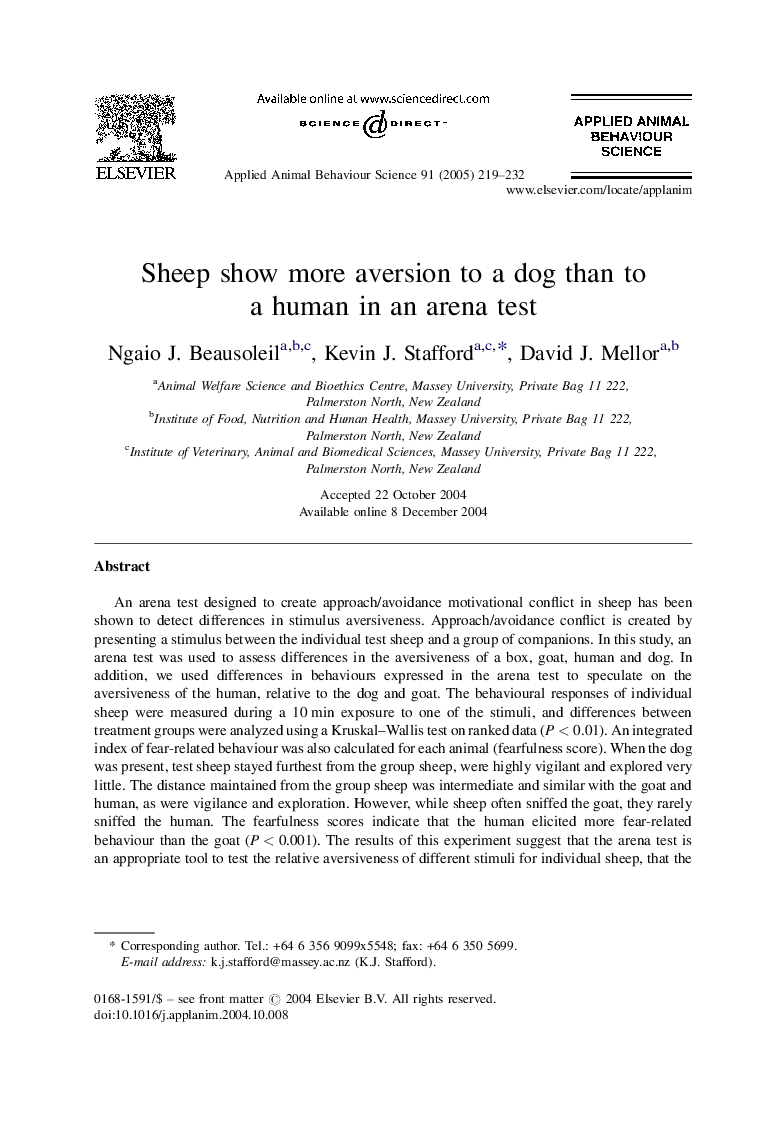| کد مقاله | کد نشریه | سال انتشار | مقاله انگلیسی | نسخه تمام متن |
|---|---|---|---|---|
| 9475931 | 1625457 | 2005 | 14 صفحه PDF | دانلود رایگان |
عنوان انگلیسی مقاله ISI
Sheep show more aversion to a dog than to a human in an arena test
دانلود مقاله + سفارش ترجمه
دانلود مقاله ISI انگلیسی
رایگان برای ایرانیان
کلمات کلیدی
موضوعات مرتبط
علوم زیستی و بیوفناوری
علوم کشاورزی و بیولوژیک
علوم دامی و جانورشناسی
پیش نمایش صفحه اول مقاله

چکیده انگلیسی
An arena test designed to create approach/avoidance motivational conflict in sheep has been shown to detect differences in stimulus aversiveness. Approach/avoidance conflict is created by presenting a stimulus between the individual test sheep and a group of companions. In this study, an arena test was used to assess differences in the aversiveness of a box, goat, human and dog. In addition, we used differences in behaviours expressed in the arena test to speculate on the aversiveness of the human, relative to the dog and goat. The behavioural responses of individual sheep were measured during a 10Â min exposure to one of the stimuli, and differences between treatment groups were analyzed using a Kruskal-Wallis test on ranked data (PÂ <Â 0.01). An integrated index of fear-related behaviour was also calculated for each animal (fearfulness score). When the dog was present, test sheep stayed furthest from the group sheep, were highly vigilant and explored very little. The distance maintained from the group sheep was intermediate and similar with the goat and human, as were vigilance and exploration. However, while sheep often sniffed the goat, they rarely sniffed the human. The fearfulness scores indicate that the human elicited more fear-related behaviour than the goat (PÂ <Â 0.001). The results of this experiment suggest that the arena test is an appropriate tool to test the relative aversiveness of different stimuli for individual sheep, that the dog was the most aversive stimulus presented, and that the human may have been slightly more aversive than the goat.
ناشر
Database: Elsevier - ScienceDirect (ساینس دایرکت)
Journal: Applied Animal Behaviour Science - Volume 91, Issues 3â4, June 2005, Pages 219-232
Journal: Applied Animal Behaviour Science - Volume 91, Issues 3â4, June 2005, Pages 219-232
نویسندگان
Ngaio J. Beausoleil, Kevin J. Stafford, David J. Mellor,